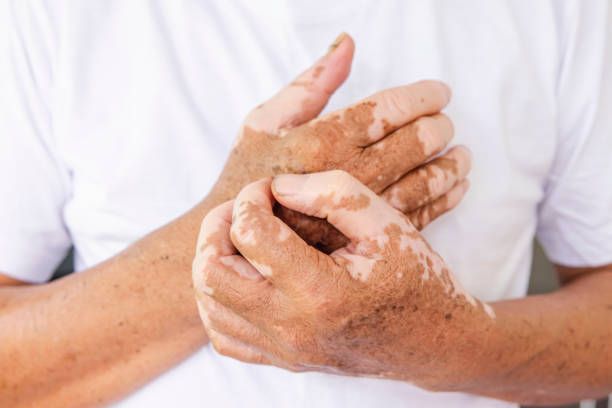
Close-up Vitiligo on skin hands of old people. medical condition causing depigmentation of patches of skin.
Does Vitiligo Have a Cure?
Vitiligo is a skin ailment in which the pigmentation of the skin is lost. White spots occur in the affected areas. It can affect any region of the body, although it is more noticeable in sun-exposed areas like the face, hands, and arms. It can affect anyone and is caused by a complex interaction of inherited, ecological, and environmental variables.
There is no cure for vitiligo, but some treatments offer promising results and can help get rid of the patches and marks caused by it.
Cure for Vitiligo
There is no one-size-fits-all treatment for vitiligo. A variety of treatments are available that may help to improve the appearance of the skin, prevent the disease from spreading, and regimentation procedures to fill in the vitiligo patches.
These treatments for vitiligo include:
– Medications: Medications such as corticosteroids, psoralen, and calcineurin inhibitors can be used to treat vitiligo.
– Light therapy: Light therapy, such as narrowband ultraviolet B (UVB) therapy, can be used to help restore pigment to the affected areas of skin.
– Surgery: Surgery may be an option for some people with vitiligo. Surgeries that may be used to treat vitiligo include skin grafting and laser therapy.
– Herbs: Many herbs have been shown to cure vitiligo pretty effectively. Herbs are non-invasive, without any side effects, and proven to treat vitiligo.
Let us have a look at these treatments in detail.
Medications
Many different medications can be used to cure vitiligo, depending on the individual’s case and the severity of their condition. Some common medications used to treat vitiligo include:
• Corticosteroids: These are a type of medication that is often used to reduce inflammation. They can be effective in treating vitiligo by helping to reduce the inflammation of the skin and promote repigmentation.
• Topical immunomodulators: Topical immunomodulators are another type of medication that can be used for vitiligo treatment. These medications work by modulating and controlling the immune system, which can help to reduce the inflammation of the skin and promote repigmentation.
• Psoralen: This medication can be taken orally or applied topically. It makes the skin more sensitive to ultraviolet (UV) light, killing unwanted, trouble-causing cells and promoting repigmentation.
Light Therapy
This is a treatment that uses light to improve the appearance of skin with vitiligo. White patches form on the skin when melanocytes, which produce pigment, die or are not able to function. Light therapy helps by stimulating the production of melanocytes or darkening the unaffected areas of the skin.
Light therapy is usually done in a doctor’s office or other medical settings. A device is used to emit ultraviolet (UV) light onto the skin. The UV light may be from artificial sources, such as lamps or natural sources. Light is applied to the affected area for a set period of time. The length of time and number of sessions will depend on the individual and the severity of vitiligo.
Some people with vitiligo may experience side effects from light therapy, such as skin irritation, redness, and blistering. It is important to talk to a doctor about the risks and benefits of this treatment before starting.
Surgery
Surgery is the most common treatment for vitiligo. There are a few different types of surgery that can be used:
1. Skin grafting: This is where a piece of healthy skin is taken from another part of the body and transplanted onto the area with vitiligo. This is usually done in small areas affected by vitiligo.
2. Micropigmentation: This involves tattooing the skin with a special type of ink that contains skin pigment. This treatment is effective but very painful, especially near the ribcage where the skin is really thin.
3. Excimer laser therapy: This uses a laser to target the affected area and stimulate the growth of new skin cells. This works similarly to light therapy, but micro incisions might be made before the treatment making this process invasive.
Surgery is not always successful, and it can be expensive. It is also not suitable for everyone, so it is important to speak to a doctor about the risks and benefits before deciding.
Is There A Way We Can Cure Vitiligo Organically?
Herbs have been used for centuries to cure a variety of illnesses. They are very effective and better than using any steroids for the long term. According to research, some herbs that are known to help with vitiligo are:
1. Berberis Vulgaris- This herb has been shown to help improve the skin’s pigmentation. This is likely due to the presence of flavonoids and terpenes in the herb. These compounds help to protect the skin from oxidative damage, which can lead to a loss of pigment.
2. Red clover- Red clover is another herb that can help improve the skin’s pigmentation. Research suggests this herb is rich in isoflavones, which are a type of phytonutrient. These compounds help to protect the skin from oxidative damage, which can lead to a loss of pigment.
3. Turmeric- Turmeric is an effective treatment for vitiligo. The herb is rich in curcumin, a compound that helps protect the skin from oxidative damage. Curcumin also helps to restore the color of the skin.
4. Ginkgo biloba- Ginkgo biloba is an herb that can help improve blood circulation and aid in the regeneration of skin cells. The herb is also rich in antioxidants, which help to protect the skin from damage.
5. Grape seed extract- The grape seed extract is an antioxidant that can help protect the skin from damage caused by free radicals. The antioxidant aids in scavenging free radicals and preventing skin damage. The extract also aids in the regeneration of skin cells by improving blood circulation.
6. Green tea- Green tea is high in antioxidants and has been proven to help heal vitiligo. Antioxidants assist in scavenging free radicals and protecting the skin from harm. The extract can also aid in skin cell renewal by improving blood circulation.
7. Cullen Corylifolium- This helps improve the skin’s pigmentation. The herb is rich in anthraquinones, which are a type of phytonutrient. These compounds help to protect the skin from oxidative damage, which can lead to a loss of pigment.
8. Coconut Oil- Coconut oil is a natural remedy used for centuries to treat various skin conditions, including vitiligo. The fatty acids in coconut oil can help to moisturize the skin and improve its overall health. Coconut oil also has anti-inflammatory properties that can help to reduce the appearance of vitiligo. Coconut oil can help improve the appearance of the skin and make it more comfortable.
9. Nigella Sativa Seeds- Nigella Seeds can regulate the immune system’s activity, preventing it from becoming too active or inactive. According to studies, these seeds have shown outstanding results against vitiligo.
Herbal remedies come in several varieties, including teas, pills, and tinctures. Within weeks, you might notice benefits if you use the appropriate combination of herbs.
These unique blends may be bought online and are shown to work. The herbal combination of topical medication is a treatment for vitiligo. It contains the optimal blend of herbs for rapid repigmentation.
How Vitiligo Organics Helpful In The Treatment Of Vitiligo?
If you are looking for an effective treatment for vitiligo-affected skin and have always ended up with no treatment available information, you should prove them wrong and try vitiligo organics.
Vitiligo Organics is the most effective, herbal, and non-invasive cream on the market. It has shown remarkable results in repigmentation and curing vitiligo for thousands of patients worldwide. It is completely organic and has zero side effects.
Vitiligo Cure: Conclusion
If you have vitiligo, therapy is necessary to enhance your skin’s look and prevent additional pigment loss. Phototherapy, topical creams and ointments, and surgery are just a few vitiligo therapies available.
Your best treatment choice will be determined by the severity of your vitiligo, your age, overall health, and personal preferences. The most effective, safe, and permanent of these treatments listed is the use of the right herbs.
These therapies can take a few months to complete, but they have proven effective in many situations. But if you’re determined and consistent, you’ll be able to get your bright, silky skin back in no time.






